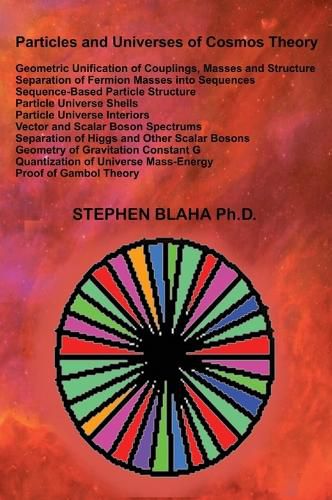Readings Newsletter
Become a Readings Member to make your shopping experience even easier.
Sign in or sign up for free!
You’re not far away from qualifying for FREE standard shipping within Australia
You’ve qualified for FREE standard shipping within Australia
The cart is loading…






This book unravels known experimental data to uncover hidden features within particles - their masses, their interaction coupling constants and their structure. Elementary particles are reduced to their essential form as "mass-energy aggregations" within miniscule universe shells. Fundamental particles and universes are shown to have similar forms.
Conventional theories of elementary particles use Perturbation Theory within the framework of Quantum Field Theory to determine effective coupling constants and particle masses as well as determining scattering amplitudes in elementary particle interactions. The success of this approach varies. It calculates some quantities such as in pure Quantum Electrodynamics with great accuracy. The status is not well understood in other areas. Renormalized coupling constants and particle masses are difficult to ascertain. The Higgs Mechanism does provide estimates of some quantities. Its success is problematic since it fits input values to obtain results consistent with experiment. The origin of these input values is usually not specified. The result is not a deepening of our understanding of particle physics.
The author's approach in this book, and in previous books, is to take the known experimental values, which are the "renormalized" values that perturbation theory should generate (if the perturbation theory calculations could be performed), and from these renormalized values ("the answers") develop an understanding of the coupling constants, the particle masses, and the interior dynamics of particles. The result is a true deepening of our understanding of elementary particle physics.
Cosmos Theory is "universe friendly." It supports perturbation theory in a number of dimensions (for all universes) using the author's Two Tier Theory to obtain finite results in any order of perturbation theory in a universe of any dimension. (No infinities!) It also supports Connection groups in all universes that "connect" all particles. No hidden particles.
The book proves all fermions and hadrons have a gambol interior of mass-energy of the form described by the author previously.
There are important new details on many topics:
On the Cosmos Parent universe consistency condition,
On coupling constants including Gravitation's G,
On the structures of fermion masses as two sequences,
On the reduction of each sequence to a nested set of "boxes",
On Vector and Scalar bosons and their separation into Higgsian and
non-Higgsian,
On the spectrum of universes in any dimension,
On the structure of fundamental quarks and leptons as miniscule universe shells,
On the mass-energy of a fermion universe shell,
On particle mass-energy within shells,
On the total mass-energy spectrum of universes within universes,
On a proposed set of new heavy neutrinos,
On the derivation of Gambol Theory from the mass sequences of fermions,
The basic forms of Cosmos Theory and universes are now understood.
$9.00 standard shipping within Australia
FREE standard shipping within Australia for orders over $100.00
Express & International shipping calculated at checkout
This book unravels known experimental data to uncover hidden features within particles - their masses, their interaction coupling constants and their structure. Elementary particles are reduced to their essential form as "mass-energy aggregations" within miniscule universe shells. Fundamental particles and universes are shown to have similar forms.
Conventional theories of elementary particles use Perturbation Theory within the framework of Quantum Field Theory to determine effective coupling constants and particle masses as well as determining scattering amplitudes in elementary particle interactions. The success of this approach varies. It calculates some quantities such as in pure Quantum Electrodynamics with great accuracy. The status is not well understood in other areas. Renormalized coupling constants and particle masses are difficult to ascertain. The Higgs Mechanism does provide estimates of some quantities. Its success is problematic since it fits input values to obtain results consistent with experiment. The origin of these input values is usually not specified. The result is not a deepening of our understanding of particle physics.
The author's approach in this book, and in previous books, is to take the known experimental values, which are the "renormalized" values that perturbation theory should generate (if the perturbation theory calculations could be performed), and from these renormalized values ("the answers") develop an understanding of the coupling constants, the particle masses, and the interior dynamics of particles. The result is a true deepening of our understanding of elementary particle physics.
Cosmos Theory is "universe friendly." It supports perturbation theory in a number of dimensions (for all universes) using the author's Two Tier Theory to obtain finite results in any order of perturbation theory in a universe of any dimension. (No infinities!) It also supports Connection groups in all universes that "connect" all particles. No hidden particles.
The book proves all fermions and hadrons have a gambol interior of mass-energy of the form described by the author previously.
There are important new details on many topics:
On the Cosmos Parent universe consistency condition,
On coupling constants including Gravitation's G,
On the structures of fermion masses as two sequences,
On the reduction of each sequence to a nested set of "boxes",
On Vector and Scalar bosons and their separation into Higgsian and
non-Higgsian,
On the spectrum of universes in any dimension,
On the structure of fundamental quarks and leptons as miniscule universe shells,
On the mass-energy of a fermion universe shell,
On particle mass-energy within shells,
On the total mass-energy spectrum of universes within universes,
On a proposed set of new heavy neutrinos,
On the derivation of Gambol Theory from the mass sequences of fermions,
The basic forms of Cosmos Theory and universes are now understood.